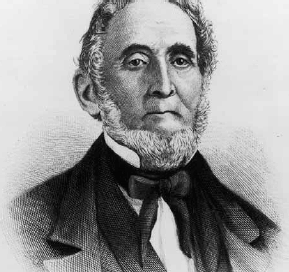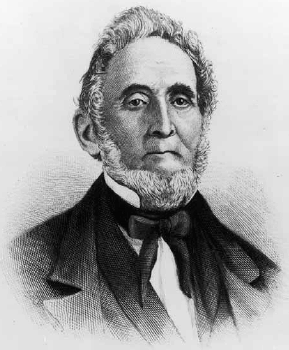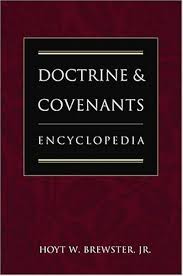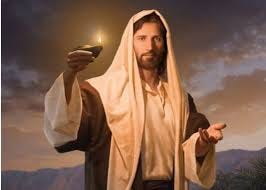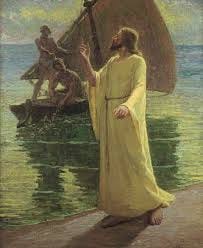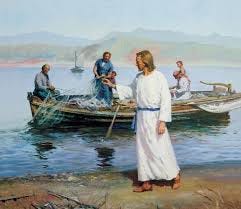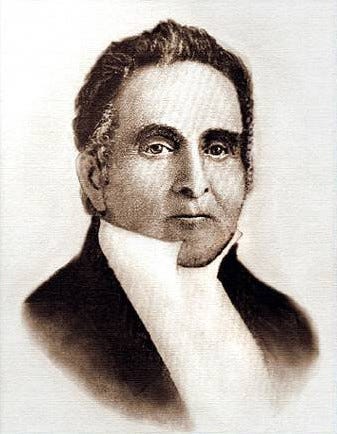Sidney Rigdon: A Very Great and Good Man
Background Information on Doctrine and Covenants 35
On October 15, 1830 the four missionaries (Parley P. Pratt, Ziba Peterson, Oliver Cowdery, and Peter Whitmer) arrived in Mentor, Ohio, and introduced the Restored Gospel of Jesus Christ to Sidney Rigdon. Sidney Rigdon (see also here, here, and here) was an influential preacher whom Parley P. Pratt followed before discovering the Book of Mormon. Rigdon refused to debate his former follower, Parley P. Pratt, but he agreed to study the Book of Mormon alone. During the two weeks that followed, Sidney Rigdon was converted to the Restored Gospel of Jesus Christ.
During this same time period, Joseph Smith the Prophet had begun to translate the Bible. On December 10, 1830, Sidney Rigdon and Edward Partridge arrived in Fayette, New York from Kirtland, Ohio to meet the Prophet. In mid December of 1830, in response to a visit from Sidney Rigdon and Edward Partridge, the Lord revealed to Joseph Smith what are now sections 35 and 36 of the Doctrine and Covenants. As also noted in J. Christopher Conkling’s A Joseph Smith Chronology, the Lord revealed to Joseph some of the lost books of the Bible and the Prophecy of Enoch.
We’ve already mentioned Sidney Rigdon and Edward Partridge in previous posts (see e.g. here, here, here, here, here, here, here, here, here, and here), but who were they? Let’s begin with Sidney Rigdon in this post, and then we’ll learn more about Edward Partridge in a future post.
This is the entry on Rigdon, Sidney in Hoyt W. Brewster Jr.’s Doctrine & Covenants Encyclopedia:
With the exceptions of Joseph Smith and Oliver Cowdery, the name of Sidney Rigdon appears more often in the Doctrine and Covenants than any other. After having served as a very popular preacher for the Baptists, Campbellites, and on his own, Rigdon became convinced of the truthfulness of the restored gospel by a careful and prayerful reading of the Book of Mormon. He was baptized on November 14, 1830, and many with whom he had previous religious association chose to follow Sidney’s example in investigating this new faith.
Only a month later, his name appeared in one of the revelations wherein the Lord said to him, “I say unto you my servant Sidney, I have looked upon thee and thy works. I have heard thy prayers, and prepared thee for a greater work…. Thou was sent forth, even as John, to prepare the way before me” (D&C 35:3-6.) Thus, while previously not having had the complete truth, the Lord had used Sidney to prepare a people for the Restoration.
In March 1833, Sidney was set apart as a counselor to Joseph Smith in the Presidency of the Church (D&C 90:6). Sidney was a gifted orator and was called by revelation to be a “spokesman” for Joseph Smith (D&C 100:9). This was the fulfillment of an ancient prophecy uttered by Joseph who was sold into Egypt, thousands of years prior to this time (2 Ne. 3:18; JD 25:126-27).
Early in his ministry, Joseph Smith said of his counselor: “Brother Sidney is a man whom I love, but he is not capable of that pure and steadfast love for those who are his benefactors, as should possess the breast of a president of the Church of Christ. This, with some other little things, such as a selfishness and independence of mind, which, too often manifested, destroy the confidence of those who would lay down their lives for him - these are his faults. But, notwithstanding these things, he is a very great and good man; a man of great power and words, and can gain the friendship of his hearers very quickly. He is a man whom God will uphold, if he will continue faithful to his calling.” Then, the Prophet added this plea: “O God, grant that he may, for the Lord’s sake” (HC 1:443).
Unfortunately, in spite of all he suffered for the sake of truth, Sidney was not able to totally bend his will to that of the Lord’s. In August 1843, Joseph accused Sidney of acts of betrayal and withdrew the hand of fellowship from him (HC 5:532). By October 1843, Joseph endeavored to “throw Sidney off his shoulders” and have him released from the First Presidency. Joseph indicated that Rigdon had been of little value to him as a counselor since the expulsion from Missouri. However, the conference voted to retain Sidney for yet another year. (HC 6:47-49)
Following the martyrdom, Rigdon, who had been living in Pittsburgh, rushed back to Nauvoo with the suggestion that he be named as the “guardian” for the Church. At the memorable conference of August 8, 1844, Rigdon’s eloquence could not prevail above the authority of the Twelve Apostles, and his bid for leadership failed.
Though he outwardly acquiesced, he secretly told many that he held “the keys of David” and that God had instructed him to take charge of the Church. Though he initially denied disloyalty to the Twelve, the truth was revealed and he was excommunicated from the Church on September 8, 1844. His efforts at organizing a following failed, fulfilling the prophetic words of Brigham Young: “All that want to draw a party from the Church after them, let them do it if they can, but they will not prosper” (SP, 7-18; see also HC 7:223-43). See also: Pelagoram; Sidney; Spokesman (pp. 473-474)
The section on “Voices of the Restoration: Early Converts” in the LDS Come Follow Me manual contains this description of Sidney and Phebe Rigdon:
On his way from New York to a mission in Missouri, Parley Pratt and his fellow laborers stopped in Mentor, Ohio, at the home of Sidney and Phebe Rigdon—old friends Parley knew from his days in Ohio. Sidney was a Christian minister, and Parley was once a member of his congregation and considered him a spiritual mentor. Parley eagerly told his friends about the Book of Mormon and the Restoration of Jesus Christ’s gospel. Sidney himself had been searching for a restoration of the true Church that he found described in the New Testament, though he was skeptical about the Book of Mormon at first. “But I will read your book,” he told his friend Parley, “and will endeavor to ascertain, whether it be a revelation from God or not.” After two weeks of study and prayer, both he and Phebe were convinced the book was true. But Sidney also knew that joining the Church would be a major sacrifice for his family. He would obviously lose his job as a minister, along with his social status in the community. As he and Phebe discussed this possibility, Phebe declared, “I have counted the cost, and … it is my desire to do the will of God, come life or come death.”
If joining the Lord’s Restored Church cost Sidney Rigdon his job and his social status as a popular minister - and he was already doing the best that he could as a faithful follower of Christ and as a preacher - imagine what it might cost the rest of us. Phebe counted the cost and desired to do the will of God, come life or death. Whatever we are called to leave behind for Christ and His Kingdom, no matter how precious it may appear to us, certainly pales in comparison to the blessings that await those who desire to do the will of God, come life or death. Sidney Rigdon was blessed to be married to such a faithful woman.
Before discovering the Book of Mormon and Joseph Smith, Sidney Rigdon, like many other early converts, had already been seeking truth:
Early Ministry
Long before Pratt and Cowdery came to his door as missionaries, Sidney Rigdon had longed for a restoration of New Testament Christianity. He was born in 1793 just outside of Pittsburgh, Pennsylvania, and trained as a tanner, but his passion for learning and preaching the word of God took him into the Christian ministry. By the time he married Phebe Brooks in 1820, he had already begun his preaching career among the United Baptists. He soon found himself within the expanding influence of Alexander Campbell’s Reformed Baptist movement, which sought a return to the forms of New Testament Christianity.
Sidney Rigdon honed his public-speaking skills as a minister of the First Baptist Church of Pittsburgh. Rigdon’s interest in reform eventually caused a rupture with the more conservative Baptist leadership of Pittsburgh, and he moved with his growing family to northeastern Ohio, where he became an influential preacher across several counties.1 He was soon chosen to lead a congregation in a town called Mentor. Rigdon emphasized early Christian practice, and some members of his congregation even launched their own attempt to live having “all things in common,” as described in the book of Acts.2
When members of his congregation began to investigate the Restored Gospel of Jesus Christ as preached by the missionaries whom the Lord sent to Ohio, Sidney Rigdon also began to investigate:
Church Service
When Pratt, Cowdery, and other missionaries stopped in Ohio on their way to preach to American Indians living west of Missouri, many members of Sidney Rigdon’s congregation embraced their message.3 After his own conversion, Rigdon traveled to New York state with his former parishioner Edward Partridge to meet Joseph Smith.4
Rigdon’s extensive biblical knowledge and powerful preaching helped nurture the young Church. Rigdon also served as a scribe for Joseph Smith’s inspired revision of the Bible and was the subject of several early revelations. When the Church’s First Presidency was first organized, Rigdon was called as Joseph’s counselor. In February 1832, Sidney and Joseph experienced a momentous vision together of the three degrees of glory, their account of which contains a powerful joint testimony of Jesus Christ.5 The next month, a mob dragged both Sidney and Joseph from their homes and then brutally attacked and tarred and feathered them.
Sidney Rigdon presided over the Saints in Kirtland while many Church leaders were away on the Zion’s Camp expedition, helped write the Lectures on Faith delivered in the School of the Prophets, spoke at the Kirtland Temple dedication, and was a key figure in the organization of the Kirtland Safety Society.6 In 1838, he moved to Missouri with Joseph Smith. In a Fourth of July address, he announced that the Saints would fight back against any mob that came to oppress them, heightening tensions between Church members and their neighbors. He was later imprisoned with Joseph in Liberty, Missouri.
This the account of Sidney Rigdon’s conversion in Revelations in Context, “Go to the Ohio”:
Sidney Rigdon’s Conversion
Then a preacher with two Reformed Baptist congregations, Rigdon was influential enough that those in his flock were known by many as Rigdonites.1 Recognizing his influence, Pratt and Cowdery called on Rigdon on October 28, but his reaction to their message was not a positive one. He skeptically accepted a copy of the Book of Mormon, and one congregant remembered that he “partly condemned it.”2 Nevertheless, he agreed to read it.
The missionaries preached a sermon in Mentor to little effect and soon moved on to Kirtland and the Isaac Morley farm, arriving November 2. Also a Reformed Baptist, Isaac Morley was the “spiritual father of a large communal family”—composed mostly of members of Rigdon’s congregations—living at his farm. As a group, the “family” sought to reestablish the gospel of Jesus Christ as described in the Bible. The missionaries found a warm reception for their message among the members of the “family” at the Morley farm and baptized many of them.
The next day, November 4, Rigdon came to Kirtland to perform a marriage and then joined the missionaries as they traveled the area preaching the message of the restored gospel. Seventeen more people were baptized the next day, and though Rigdon was not among them, within another day he had joined in the preaching and, according to one observer, was “much affected and shedding tears” at the meeting.3
By Sunday, November 7, the preaching drew a crowd so large that listeners spilled outside and someone pulled boards off the building so the overflow crowd could hear. Parley P. Pratt taught from the Book of Mormon and then invited others to speak—an invitation Sidney Rigdon quickly accepted. Rigdon stood and announced that after hearing the missionaries’ message, he “should never try to preach again” and urged listeners not to contend against what they had heard.
Rigdon had become convinced that the missionaries did, indeed, have authority previously not found on the earth. He desired to be baptized and discussed the matter with his wife, Phebe, warning her of how their lives might change if they obeyed the gospel:
“‘My dear, you have once followed me into poverty; are you again willing to do the same?’ She answered, ‘I have weighed the matter; I have contemplated … the circumstances in which we may be placed; I have counted the cost, and I am perfectly satisfied to follow you. Yea, it is my desire to do the will of God, come life or come death.’”4
Phebe and Sidney followed in the footsteps of the ancient Apostles who, when the Savior called them, straightway left their nets, and followed Him. (see Matt. 4:19-20)
In their book Joseph Smith and the Doctrine and Covenants, Milton V. Backman and Richard O. Cowan provide more helpful background for understanding the revelation contained in D&C 35:
Before the missionaries to the Lamanites left Ohio, they called Sidney Rigdon to be a leader over the Saints. He recognized his need for assistance, because he had just been baptized and did not know many principles of belief or practice. He decided to travel east, find Joseph, and seek counsel. He was accompanied by one of his followers, Edward Partridge, a successful hatter in nearby Painesville, who was delaying his baptism until he had personally met Joseph and received a witness of the Prophet’s divine calling. Lydia Partridge recalled that when her husband began the journey, he was not fully convinced of the truth of the gospel taught by the elders.
Because Edward Partridge was noted for his integrity, other “inquirers” awaited Edward’s appraisal of Joseph Smith’s character before making up their minds. (Backman, Heavens Resound, p. 40) Meanwhile, Joseph Smith, Sr., had moved from Manchester to a home east or Waterloo, not far from Fayette, where the Church had been organized. Lucy Mack Smith described the events that occurred in her home when the two strangers from Ohio first met her son:
“In December [1830], Joseph appointed a meeting at our house. While he was preaching, Sidney Rigdon and Edward Partridge came in and seated themselves in the congregation. When Joseph had finished his discourse, he gave all who had any remarks to make, the privilege of speaking. Upon this, Mr. Partridge arose, and stated that he had been to Manchester, with the view of obtaining further information respecting the doctrine which we preached; but, not finding us, he had made some inquiry of our neighbors concerning our characters, which they stated had been unimpeachable, until Joseph deceived us [them] relative to the Book of Mormon. He also said that he had walked over our farm, and observed the good order and industry which it exhibited; and, having seen what we had sacrificed for the sake of our faith, and having heard that our veracity was not questioned upon any other point than that of our religion, he believed our testimony, and was ready to be baptized, ‘if,’ said he, ‘Brother Joseph will baptize me.’
‘You are now,’ replied Joseph, ‘much fatigued, brother Partridge, and you had better rest to-day, and be baptized tomorrow.’
“‘Just as Brother Joseph thinks best,’ replied Mr. Partridge, ‘I am ready at any time.’
“He was accordingly baptized the next day [11 December 1830]” (History, pp. 191-92).
The Prophet recorded that shortly after the arrival of Sidney Rigdon and Edward Partridge, the Lord spoke to him concerning them, giving the revelations that are now Doctrine and Covenants 35 and 36 (History of the Church, 1:128) (pp. 42-43)
The rest of Backman and Cowan’s account of Sidney Rigdon is also essential for better understanding Sidney Rigdon and the revelation that was given to him in D&C 35 (see also The Revelations of the Prophet Joseph Smith, pp. 51-53):
During the 1820s Sidney Rigdon had been influenced by the teachings of Alexander Campbell and was a successful restorationist preacher in Ohio, but when Campbell began organizing followers in 1830 in a movement that became the Disciples of Christ, Rigdon refused to unite with them. Unlike Campbell, Rigdon believed in a restoration of God’s power and in the establishment of a communal order of living. Unlike the Latter-day Saints, Rigdon believed that the Bible was the sole standard of faith and that when individuals accepted Christ they were thereby endowed with God’s authority without the need of special ordination. After listening to the Latter-day Saint missionaries, the former Baptist preacher recognized significant differences between the teachings of Alexander Campbell and Joseph Smith. Some of these differences were identified in the revelation recorded by the Prophet shortly after meeting Rigdon: “Behold thou was sent forth, even as John,” the revelation read, “to prepare the way before me.” Before his conversion to Mormonism, the revelation continued, Rigdon “baptized by water unto repentance but they received not the Holy Ghost.” After he had received God’s authority, individuals who were baptized by him would “receive the Holy Ghost by the laying on of hands.” This revelation further emphasized that “miracles, signs, and wonders” would be manifest among believers (D&C 35:4-9)
Three years later, Sidney Rigdon would be called as a “spokesman” for Joseph Smith and the Church (D&C 100:9). In that capacity, he published a series of articles in the Latter Day Saints’ Messenger and Advocate, emphasizing differences between the “Restoration” as taught by the Prophet Joseph Smith and that taught by other faiths. He affirmed that the biblical prophecy regarding restitution of all things included a restoration of “all spiritual gifts” and “every blessing which had ever been enjoyed among men from the first to the last” (Messenger and Advocate, May 1835, p. 117). Rigdon added that Joseph Smith not only restored correct beliefs, such as the principle of the laying on of hands for the gift of the Holy Ghost, but also received God’s power and authority. He further testified that this restored power included revelations, visions, healing, prophecy, and speaking in tongues.
Sidney Rigdon was also called by revelation to be a scribe in making what came to be known as the Joseph Smith Translation of the Bible (D&C 35:20, 23), restoring, clarifying and correcting the biblical text by inspiration - a work that began as early as June 1830. Immediately he began writing asa the Prophet dictated to him, and he assisted the Prophet in recording the visions and prophecy of Enoch and other portions of the Old Testament. After the Saints moved to Ohio, Rigdon served as scribe for more of Joseph’s translation of the New Testament than any other person.
Because of Rigdon’s education, maturity, and eloquence as a speaker, early critics claimed that he was the dominant influence in the translation of the Bible and was the principal author of the Book of Mormon. Refuting these allegations, however, Sidney Rigdon emphatically reiterated his testimony. According to his son John, “My father … looked at me a moment and slowly raised his hand above his head and slowly said, with a tear glistening in his eyes: 'My son, I can swear before high heaven that what I have told you about the origin of that book is true. Your mother and sister, Mrs. Athalia Robinson, were present when that book was handed to me in Mentor, Ohio, and all I ever knew about the origin of that book was what Parley P. Pratt, Oliver Cowdery, Joseph Smith, and the witnesses who claimed they saw the plates have told me, and in all of my intimacy with Joseph Smith, he never told me but the one story, and that was he found it engraved upon gold plates in a hill near Palmyra, NY, and that an angel had appeared to him and directed him where to find it, and I have never to you or anyone else told but [this] one story, and that I now repeat to you’” (“Life Story,” pp. 193-94)
The Lord had made a distinction between the roles of Joseph, who was to “prophesy,” and of Sidney, who was to call on the scriptures to prove that Prophet’s words (D&C 35:23). Consequently, for many years, Sidney Rigdon, serving as first counselor in the First Presidency, used his knowledge of the scriptures to substantiate and promulgate the truths taught by the Prophet Joseph Smith. (pp. 43-45)
Although Sidney Rigdon’s relationship with the Prophet Joseph Smith was later strained, Sidney Rigdon was a good and a great man (as is evidenced by the Prophet’s compliments for him and this revelation of the Lord to him) who suffered tribulation and persecution because of his devotion to Christ.
As indicated in McConkie’s section heading, toward the end of 1830 the Prophet Joseph Smith was engaged almost daily in making a translation of the Bible. Oliver Cowdery and John Whitmer had previously served as scribes for this work until the Lord called Sidney Rigdon to serve as the Prophet’s scribe. Sidney Rigdon and Edward Partridge came from Ohio to inquire of the Lord, and Doctrine and Covenants 35 contains the Lord’s response to Sidney Rigdon in particular. Let’s examine and expound upon this revelation in the following post.


